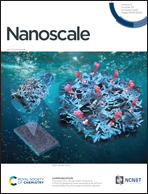Ultrathin Bi2O2S nanosheet near-infrared photodetectors†
Abstract
Recently, a zipper two-dimensional (2D) material Bi2O2Se belonging to the layered bismuth oxychalcogenide (Bi2O2X: X = S, Se, Te) family, has emerged as an alternate candidate to van der Waals 2D materials for high-performance electronic and optoelectronic applications. This hints towards exploring the other members of the Bi2O2X family for their true potential and bismuth oxysulfide (Bi2O2S) could be the next member for such applications. Here, we demonstrate for the first time, the scalable room-temperature chemical synthesis and near-infrared (NIR) photodetection of ultrathin Bi2O2S nanosheets. The thickness of the freestanding nanosheets was around 2–3 nm with a lateral dimension of ∼80–100 nm. A solution-processed NIR photodetector was fabricated from ultrathin Bi2O2S nanosheets. The photodetector showed high performance, under 785 nm laser illumination, with a photoresponsivity of 4 A W−1, an external quantum efficiency of 630%, and a normalized photocurrent-to-dark-current ratio of 1.3 × 1010 per watt with a fast response time of 100 ms. Taken together, the findings suggest that Bi2O2S nanosheets could be a promising alternative 2D material for next-generation large-area flexible electronic and optoelectronic devices.



 Please wait while we load your content...
Please wait while we load your content...